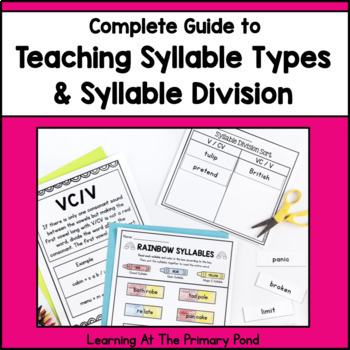Complete Guide to Teaching Syllable Types & Syllable Division
- Zip
What educators are saying
Description
This is a pack of lesson plans and practice activities to help you teach students all the syllable types (i.e. open and closed syllables), the syllable division rules (i.e. VC/CV), and how to divide and decode multisyllabic words! This resource will also help you implement the science of reading!
Many phonics and reading programs neglect to include multisyllabic word instruction. But teaching kids to break up multisyllabic words is incredibly important - otherwise, they end up stumbling or guessing their way through longer words!
You can “start small” when teaching kids to break up words, with 2-syllable compound words made up of CVC words put together. As students’ phonics knowledge grows, you’ll teach them to decode multisyllabic words with consonant blends and digraphs, inflectional endings -ES and -ED, glued sounds, open and closed syllables, r-controlled vowels, vowel teams, diphthongs, and more.
This program will seamlessly integrate into any phonics or reading program that you’re already using. The table of contents tells you exactly when to teach each lesson (example: after students have learned how to read and write 1-syllable silent e words).
This is not a complete phonics program in itself, but it is a complete guide to teaching syllable division rules and syllable types that can fit into any phonics or reading program.
Here’s what’s included:
- Table of contents with pacing guidance
- Video link with examples of how to teach syllable division
- Complete, detailed lesson plans (30 lessons total) with step-by-step directions
- Posters and visuals for the syllable types, syllable division rules, and multisyllabic word reading process
- Word strips and half-sheet options with words for students to practice dividing
- Syllable sorts, puzzles, worksheets, and activities for follow-up practice
Topics covered:
- Concept of a syllable
- VC/CV syllable division rule, including with consonant digraphs and blends
- Multisyllabic words with -es and -ed
- Multisyllabic words with glued sounds (-nk and -ng)
- Open and closed syllables
- V/CV syllable division rule
- Magic e / silent e syllables
- VC/V syllable division rule
- R-controlled syllables
- Vowel team syllables
- Consonant-l-e syllables
- Diphthong syllables
- V/V syllable division rule
1st grade teachers will likely use this program throughout the year, teaching syllable types and rules periodically as they relate to your existing phonics instruction. The lessons will not necessarily be taught one after the other (pacing guidance is included).
2nd grade teachers, 3rd grade teachers, and reading teachers may teach many of the lessons in sequence, so that students quickly get up to speed with their multisyllabic word reading skills.
Important: If you use From Sounds to Spelling, the Learning At The Primary Pond phonics program, you will not need this resource, because multisyllabic word instruction is included in the 1st and 2nd grade levels of the program.
Please download the FREE preview to see a list of all the lessons included in this resource!





